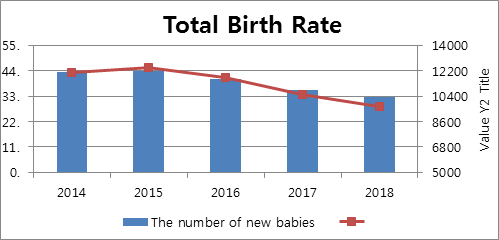 |
| This graph shows birthrate from 2014 to 2018 |
Everyone knows that Korea’s birthrate is a serious problem. The government has come up with various policy alternatives and invested more than 120 trillion won (an astronomical amount), but there are no tangible results so far. The current low birthrate policy is centered on the ‘housing support, expansion of free child care and education, payment of child benefits, expansion of public child homes, and nursing classrooms’. The fact that the birthrate is decreasing despite these policies means that the current policies have not had much impact on having children. So, why is the situation getting worse?
In order to find out what is the real essential cause of low birthrates, we must look at who is not giving birth and what are the fundamental problems. According to a report by the National Assembly Budget Office, ‘The causes and Economic Impacts of Low Births in Korea’, the probability of getting married within a year has decreased by 3.7 percent for people who work at night or on weekends. Conversely, the probability of marriage increased by 7.1 percent for those with a long distance commute, and increased more than 10 percent for those with a telecommuting system. That is to say, the current working environment is affecting the probability of marriage.
According to the Korean Institute for Health and Social Affairs and the Korea Housing Welfare Forum, the percentage of single-person households that experienced both the minimum housing standards and excessive rent burden increased steadily from 17.1 percent in 2006 to 46.8 percent in 2019. Analysts say that it is difficult to make up one’s mind to get married when one’s housing is not stable at the moment and one is suffering from financial difficulties.
Despite the situation, Kim Hak-yong of the Liberty Korea Party recently said “These days, young people who want to be happy don’t want to have children because they want to live well themselves”. Has the selfishness of young people caused the declining birthrate, as Kim Hak-yong said?
Young people can’t afford to get married and have beautiful children who look like them. Even if one pays monthly rent and makes a living, it is a luxury to have a normal house amid skyrocketing housing prices. It is also difficult to have time to raise children while working full-time and overtime. But these are not the only problems. The gender discriminatory structure that is firmly rooted in society also makes people avoid giving birth. According to the Ministry of Employment and Labor’s ‘statistics of the labor market’ last year, 70% of women in their 20’s work, while only 50% of women in their 30’s work. In the labor market, women who give birth often face a career break due to recommended resignation or unreasonable personal changes. Moreover, women spent an average of 229 minutes on child care during weekdays, five times longer than men, who spent only 46 minutes on average.
In such a society where it is difficult to manage one’s own body, marriage and childbirth are very hard decisions that require substantial sacrifices. The current low birthrate measures cannot solve most of these essential problems. If South Korea does not want to lose its potential growth, we need a fundamental low birthrate policy, not an ineffective one.
By Park-Junho, reporter
박준호 micheen12@naver.com
<저작권자 © The Campus Journal, 무단 전재 및 재배포 금지>

 Shrinkflation, Consumer Deception
Shrinkflation, Consumer Deception




